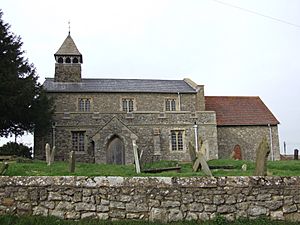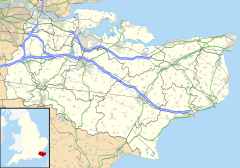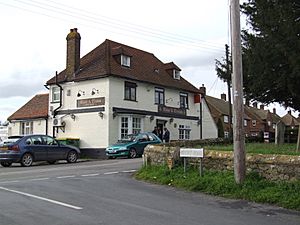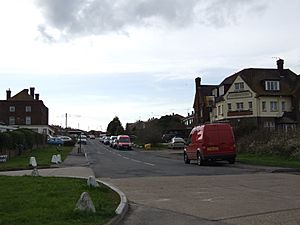Allhallows, Kent facts for kids
Quick facts for kids Allhallows |
|
|---|---|
 |
|
| Population | 1,676 (2011) |
| OS grid reference | TQ844783 |
| Civil parish |
|
| Unitary authority | |
| Ceremonial county | |
| Region | |
| Country | England |
| Sovereign state | United Kingdom |
| Post town | ROCHESTER |
| Postcode district | ME3 |
| Dialling code | 01634 |
| Police | Kent |
| Fire | Kent |
| Ambulance | South East Coast |
| EU Parliament | South East England |
| UK Parliament |
|
Allhallows is a village in Kent, England. It's located on the Hoo Peninsula. This village is in the northern part of Kent. It covers about 24 square kilometers. The River Thames is to its north. Yantlet Creek, which is now filled with mud, is to its east. In 2011, about 1,676 people lived here.
Allhallows has two main parts. One is the old village called Hoo All Hallows. The other is a holiday area from the 20th century, known as Allhallows-on-Sea.
West of the village is Windhill Green. There used to be a small group of houses there. All the old buildings are gone now. Only the name of the place remains.
Contents
Hoo All Hallows: The Old Village
Hoo All Hallows is built around its church. The church is called All Saints. The village gets its name from this church. Hallow means Saint. The word Hoo refers to a piece of land that sticks out. This is why many places on the Hoo Peninsula have Hoo in their name.
The church records for Hoo All Hallows started in 1629. In 1841, 268 people lived in the village.
All Saints' Church History
All Saints' Church was built in the 12th century. It is the only building in the area with a special Grade I listing. This means it's very important historically. The church is made of flint and stone. It has a lead roof.
The oldest part of the church is the west end. Other parts were added later. The north side was built in the early 13th century. The arch and screen near the altar are from the 14th century. Money was given in 1472 to help build the main part of the church. The area around the altar was fixed up a lot between 1886 and 1891.
A family called Pympe once lived here. They had a large house known as "Allhallows House."
Yantlet Creek was once a busy waterway. It was used for trade and had defenses. People used it from Roman times. The Saxon Shore Way walking path goes near its old edges. This shows how the creek has filled up with mud over many centuries.
Avery Farm's Ancient Past
Avery Farm is on a piece of land that sticks out. In Anglo-Saxon times, this land might have been its own island. It is thought to have belonged to a woman named "Heahburh." She might have been an abbess, which is a leader of a group of nuns. This land was given to a monastery in Peterborough by King Cædwalla of Wessex in the 7th century.
Allhallows-on-Sea: The Holiday Village
The modern holiday village of Allhallows-on-Sea is by the river. It is about 1 kilometer north of the old village.
After the First World War, there were big plans for Allhallows. Local councils wanted to turn it into a major seaside resort. They wanted it to be like the popular Victorian resorts.
In 1937, a newspaper reported on the plans:
- An amusement park would be built. It would be very large.
- The park would include a zoo and a yachting center.
- There would be a huge swimming pool with artificial waves.
- Plans also included a holiday camp and 5,000 houses.
- New hotels, restaurants, theaters, and cinemas were also planned.
- This big project was expected to take about seven years. It would cost millions of pounds.
The Southern Railway opened a train line to Allhallows in the 1930s. The Allhallows-on-Sea railway station opened on May 16, 1932. The new part of the village grew around this station.
However, the big plans for the resort never fully happened. This was partly because World War II started. The train station closed on December 4, 1961.
Today, there is a holiday park in Allhallows-on-Sea. It has a 9-hole golf course. There is also a lake for freshwater fishing. The park has a small entertainment area with indoor and outdoor swimming pools. This park is run by Haven Holidays.
A large pub called the British Pilot was built in the 1930s. It took the place of the old village inn, the Rose and Crown Tavern. The Rose and Crown is now a house. The British Pilot pub itself closed in 2021.
Allhallows During World War II
On October 15, 1940, during World War II, a Royal Air Force plane was fighting over the River Medway. A Supermarine Spitfire plane was damaged by enemy fire. The pilot had to jump out of the plane. The aircraft crashed near Allhallows on the river's edge. The pilot was saved by the Royal Navy. The plane stayed in the mud until 1998, when it was dug up.
Future Ideas for Allhallows
In 2011, some ideas were suggested for the area. These ideas were part of a plan called the Thames Hub integrated infrastructure vision. They included building a new river barrier and a road crossing. There were also plans for a shipping and rail complex.
One idea was to build a new airport. This airport would be on the nearby Isle of Grain. It would be partly on land taken from the river. It would also use land in Allhallows and Lower Stoke. This airport plan was very controversial. While the road crossing is still being planned, the other ideas were stopped. The airport plan was officially abandoned in July 2015.
Images for kids
See also
 In Spanish: Allhallows (Kent) para niños
In Spanish: Allhallows (Kent) para niños






